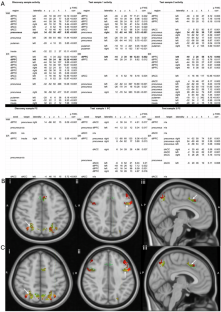三个独立年轻成人样本在工作记忆和情绪调节过程中的神经标记预测终生抑郁和躁狂/狂躁症风险
IF 9.6
1区 医学
Q1 BIOCHEMISTRY & MOLECULAR BIOLOGY
引用次数: 0
摘要
终生抑郁和躁狂症/躁狂症风险的病理生理过程的客观标志物可以为新型干预措施提供生物信息目标,从而帮助具有亚症状的个体预防情感障碍的发生。中央执行网络(CEN)支持情绪调节(ER)子成分过程,如工作记忆(WM);默认模式网络(DMN)支持自我相关信息处理;显著性网络(SN)则支持情绪调节子成分过程。我们使用了一种旨在检查 WM 和 ER 能力的情绪回溯范式,在年轻成人中研究了:(1) 这些网络中的活动和功能与终生抑郁和躁狂/狂躁症风险之间的关系;(2) 这些关系对终生抑郁风险和终生躁狂/狂躁症风险的特定程度;(3) 第一个发现样本 n = 101,63 名女性,年龄 = 23.85 (2.9) 的研究结果是否可以在两个独立的年轻成人测试样本中复制:测试样本 1:n = 90,女性 60 人,年龄 = 21.7 (2.0);测试样本 2:n = 96,女性 65 人,年龄 = 21.6 (2.1)。情绪谱自我报告(MOODS-SR-L)评估终生躁狂症/躁郁症风险和抑郁症风险。在每个测试样本中,我们都在解剖掩膜的相似位置发现了与 "发现 "样本中的每种对比度有关的重要活动集群,并且,使用从这些集群中提取的平均 BOLD 信号作为 IV,我们在每个测试样本中都发现了与 "发现 "样本中相似的 IV-DV 关系模式。具体来说,在 "发现 "样本中,WM 期间 DMN 活动越多,终生抑郁风险越大。这一发现与抑郁症有关,并在两个独立样本中得到了重复(所有 ps<0.05 qFDR)。在所有三个样本中,ER 期间 CEN 活动增加与终生抑郁风险和终生躁狂/狂躁症风险增加有关(所有 ps< 0.05 qFDR)。这些重复的研究结果为更好地识别、指导和监测青壮年抑郁和躁狂/狂躁症风险的早期干预提供了有前景的客观神经标记。本文章由计算机程序翻译,如有差异,请以英文原文为准。


Lifetime depression and mania/hypomania risk predicted by neural markers in three independent young adult samples during working memory and emotional regulation
Objective markers of pathophysiological processes underlying lifetime depression and mania/hypomania risk can provide biologically informed targets for novel interventions to help prevent the onset of affective disorders in individuals with subsyndromal symptoms. Greater activity within and functional connectivity (FC) between the central executive network (CEN), supporting emotional regulation (ER) subcomponent processes such as working memory (WM), the default mode network (DMN), supporting self-related information processing, and the salience network (SN), is thought to interfere with cognitive functioning and predispose to depressive disorders. Using an emotional n-back paradigm designed to examine WM and ER capacity, we examined in young adults: (1) relationships among activity and FC in these networks and lifetime depression and mania/hypomania risk; (2) the extent to which these relationships were specific to lifetime depression risk versus lifetime mania/hypomania risk; (3) whether findings in a first, Discovery sample n = 101, 63 female, age = 23.85 (2.9) could be replicated in a two independent Test samples of young adults: Test sample 1: n = 90, 60 female, age = 21.7 (2.0); Test sample 2: n = 96, 65 female, age = 21.6 (2.1). The Mood Spectrum Self-Report (MOODS-SR-L) assessed lifetime mania/hypomania risk and depression risk. We showed significant clusters of activity to each contrast in similar locations in the anatomic mask in each Test sample as in the Discovery sample, and, using extracted mean BOLD signal from these clusters as IVs, we showed similar patterns of IV-DV relationships in each Test sample as in the Discovery sample. Specifically, in the Discovery sample, greater DMN activity during WM was associated with greater lifetime depression risk. This finding was specific to depression and replicated in both independent samples (all ps<0.05 qFDR). Greater CEN activity during ER was associated with increased lifetime depression risk and lifetime mania/hypomania risk in all three samples (all ps< 0.05 qFDR). These replicated findings provide promising objective, neural markers to better identify, and guide and monitor early interventions for, depression and mania/hypomania risk in young adults.
求助全文
通过发布文献求助,成功后即可免费获取论文全文。
去求助
来源期刊

Molecular Psychiatry
医学-精神病学
CiteScore
20.50
自引率
4.50%
发文量
459
审稿时长
4-8 weeks
期刊介绍:
Molecular Psychiatry focuses on publishing research that aims to uncover the biological mechanisms behind psychiatric disorders and their treatment. The journal emphasizes studies that bridge pre-clinical and clinical research, covering cellular, molecular, integrative, clinical, imaging, and psychopharmacology levels.
 求助内容:
求助内容: 应助结果提醒方式:
应助结果提醒方式:


